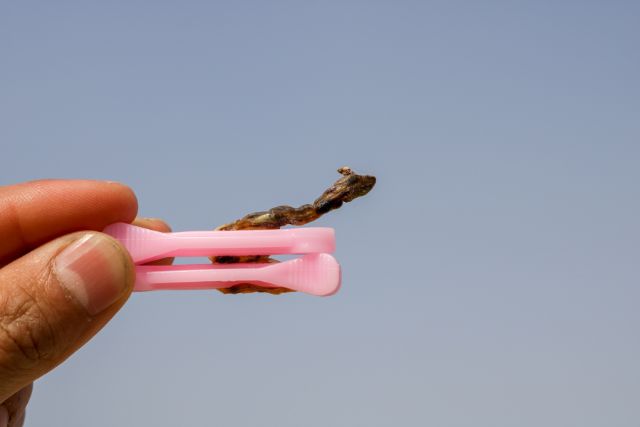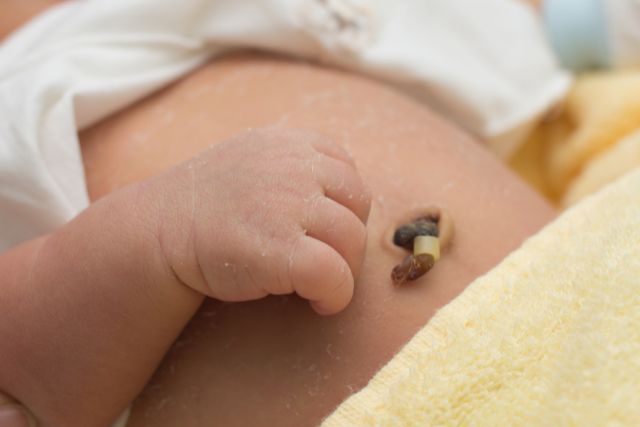181
Worried about your baby umbilical cord? Here is how to care for umbilical cord of a newborn. Learn the best daily practices that will ensure your baby’s Umbilical cord heals faster.
For a new mother, one of the emotional wrecking issues after childbirth is how to take care of your baby’s umbilical cord. You’re given this delicate tiny human being with so much to accomplish but without a manual.
So the question is, where do you begin?
First, let’s understand the making of the umbilical cord stump.
Immediately after childbirth, your midwife’s first thing is to clap and cut off the newborn’s umbilical cord.
The newborn is now independent. And, the cord is cut since its function of circulating nutrients and oxygen is no longer needed.
You will then be left with an umbilical cord stump which is cut about two to three centimeters long from the baby’s belly button.
But you may want to know;
Does a Newborn Umbilical Cord Hurt?
No. the newborn umbilical stump does not hurt since it doesn’t contain nerve endings. It’s similar to cutting your hair or nails. It won’t feel any pain.
After the doctor cuts off the umbilical cord, your newborn remains with a clipped umbilical stump. The stump will shrivel up and fall off, revealing an adorable belly button.
How to Care for Baby Umbilical Cord
Taking care of your baby’s umbilical cord stump is relatively easy. Here are a few tips for newborn belly button care;
-
Always ensure that the cord area is dry and clean. If you notice some bleeding or watery substance, gently pat it dry with a clean baby washcloth or cotton wool.
-
If you’re using diapers, ensure that you fold down the top to keep it away from the stump. Alternatively, you may go for diaper brands that have a slight scoop in the design to prevent the diaper from rubbing against the stump.
-
Ensure you have breathable cotton clothing on your newborn and their healing belly button. Try to avoid anything too tight or fabrics that don’t breathe well.
What happens to the umbilical cord stump after birth?
Within the first 1 to 3 weeks, your newborn’s umbilical cord stump dries out and eventually falls off. However, you should gently clean the baby bally button at least twice a day using a soft washcloth or cotton wool to keep it clean and dry.
When Does Umbilical Cord Fall Off
The cord stump will remain attached for about 1 to 3 weeks. It depends on how well you take care of the belly button. If you keep the place clean, dry, and without much diaper disturbance, it may fall off within the first week after delivery. However, other parameters like infections can prolong the healing period.
What Happens If the Umbilical Cord Doesn’t Fall Off?
If you keep the belly button clean and dry, your newborn’s cord should dry and fall off naturally. If it hasn’t fallen off and it’s past three weeks, it would be best if you sought medical advice from a pediatrician.
Your health caregiver can treat the infection, if any, or sometimes use a dab of silver nitrate to hasten the falling off. But this should only be done by a medical practitioner after assessment.
Is it OK to pull off the umbilical cord?
No. You should never try to pull off the umbilical cord as the process can be fatal and may even result in infection. Instead, allow the cord stump to dry and fall off naturally. Don’t even cut it off using a razor or scissors before drying.
How do you make the umbilical cord fall off faster?
Keeping the cord area clean and dry is the best strategy to ensure that the cord falls off faster. Ensure you leave room for aeration by not covering the umbilical cord stump with the diaper. Dress your baby in cotton clothes for breathability. Never try to pull off the cord, as this can only result in infections and prolong the healing process.
How to Clean Baby Umbilical Cord
Until the belly button is fully healed and closed, you need to keep the area clean. Once the stump falls off, you may still find blood stains or some yellow-like liquid substances, which are slightly lighter than pus. Do not panic. It’s normal unless it’s smelly or the navel is swollen. To clean the belly button;
- Wash your hands clean with soap
- Take a piece of cotton wool or cotton bud
- Sock it in the surgical spirit
- Using one hand, expose the center of the umbilicus by gently pressing on the surrounding area.
- Gently clean inside by pressing on the cotton wool
- Gently Wipe the cord area.
- Continue cleaning the belly button at least twice a day until you’re convinced that the place is healed.
Now that the stump has fallen, you don’t have to worry about folding the diaper. Consequently, you may do away with some clothing protocols.
Related:
How often should I clean my baby’s belly button after the stump falls off?
Once the stump cord falls off, do not be fooled that you are off the hook. The only good thing is that your baby may now have a full bath, wholly immersed in water without fear.
Otherwise, you still need to nurse the belly button until the red-like wound closes completely. This can take between three to five days after the stump falls off.
Continue cleaning the belly button at least twice a day using surgical spirit and cotton wool or swab. You can probably do the cleaning after a bath or set it as a morning or evening routine before bed.
Is Surgical Spirit Good for Cleaning Umbilical Cord?
Yes. I’ve used surgical spirit for all my kids, and it has proved to be very effective without any side effects. Using surgical spirit can disinfect the umbilical cord, thus minimizing the probability of getting infections.
A slight dip of cotton wool in surgical spirit is enough to clean the area. Also, cotton swabs or buds can come in handy once the stump has fallen off. Don’t be scared, mama. This procedure is painless.
How do I know if my baby umbilical cord is healed?
You will know that your baby’s umbilical cord is healed if the stamp has fallen off and the belly button is closed. There will be no redness or bleeding in the navel. To be sure, you may try Exposing the umbilicus center to check what is inside. If it doesn’t open, your baby’s umbilical cord is healed.
6 Best Practices That Will Get an Umbilical Cord to Fall Off Faster
- Leave the stump to heal and fall off naturally. Do not cut or pull it off, as this can lead to infection.
- Keep the stump dry. Wipe the cord area at least three times a day to speed the healing process. You may do the cleaning in the morning, midday, and the evening or before bed.
- Sponge baths may be the best. While there’s no harm in giving your baby a full bath, sponge baths might make it easier to keep the stump dry.
- You may use warm saline water or surgical spirit when cleaning the umbilical cord. One study shows that using antiseptics can reduce the chances of infection and speed up the healing process.
- Fold the diapers so that the umbilical cord gets fresh air and does not get pulled often.
- Ensure that your newborn does not cry for long hours as the straining on the tummy when they cry can prolong the healing process.
Baby Belly Button Complications
You may come across various belly button complications. Some are unwanted conditions like “outies,” while others are infections. Here are a few examples;
“Innies” and “Outies” Baby Belly Buttons
Sometimes you may have noticed newborns with belly buttons popping out. That is called the ‘outie’ belly button. If the skin pulls inward and looks like a deep dimple, it is referred to as an “innie” belly button. These belly button conditions are formed depending on how the skin tissues around the cord area heal.
What causes an “outie” belly button in a baby?
Honestly, I have not come across any research that directly answers this question. And the myths like how the midwife cuts or clamp the umbilical stump of a newborn have nothing to do with whether a baby ends up with an “innie” or “outie” belly button.
However, some doctors have sighted out a possibility of an umbilical hernia or granuloma being the cause of an “outie” belly button.
Umbilical Hernia
According to Mayo Clinic, an Umbilical hernia or baby belly button hernia may occur when part of the intestine bulges through the opening in the abdominal muscles near your baby’s belly button.
The bulging of the intestines may create a swelling near the navel. Consequently, the swelling may become more noticeable when the baby strains, like during intensive crying or coughing.
According to doctors, Umbilical hernias condition is harmless and usually close on its own before the age of 2 without medication.
If this condition doesn’t disappear by the age of 4, surgical repair may be needed to prevent complications. You also want to seek immediate medical intervention if
-
the bulge becomes swollen or discolored
-
your baby appears to be in pain, especially with a touch on the cord
-
your baby begins to vomit
Umbilical Granuloma
sometimes after the umbilical stump has fallen off, you may have a small pinkish or red lamp on the belly button.
It can be either covered in a yellow or clear discharge. That tiny growth of tissue is what is referred to as umbilical granuloma.
An umbilical granuloma is not something to cause an alarm. In most cases, it does disappear after one or two weeks as you continue to clean the place and keep it dry.
Occasionally, an umbilical cord can become infected and cause skin irritation and fever. If that happens, you may need to consult your health care provider before the condition worsens.
If there are no signs of infection, your pediatrician may recommend a home-based treatment using salt.
- Gently press on the belly button sides to expose the umbilicus center.
- Using a clean, soft cloth soaked in warm saline water, gently clean the area
- Ensure the cord area remains clean and dry throughout the day
- You may repeat the cleaning process twice a day for about three days
- If there is no improvement, kindly rush to the hospital for more specialized treatment
Can you correct an outie belly button?
Yes. An outie belly button can be fixed through simple surgery after a baby attains age 4 or 5. But first, you should establish and deal with the cause. If it’s umbilical Granulomas, you need to be treated to avoid infection. Umbilical Hernias may disappear on their own after a while, but in case it persists, you may treat them through a simple surgery.
What are Key Signs That the Umbilical Cord is Infected?
A slight baby belly button bleeding is normal during the healing process, and there is usually nothing to be concerned about, but if you notice the following symptoms, they may be signs of infection
-
Yellow-greenish pus around the cord.
-
Persistent bleeding that you can not keep the cord area dry
-
A foul smell coming from the cord.
-
Fever.
-
A fussy, uncomfortable baby.
-
redness or discoloration
-
tenderness on the stump or belly button
-
Swelling around the cord area
If you notice any of these signs, do not hesitate to seek medication intervention immediately.
Related:
When to seek help
The umbilical cord is a sensitive area in your body since it directly accesses the bloodstream. One study shows that even mild umbilical cord infections can become fatal quickly.
You need to contact your child’s pediatrician when your baby has persistent bleeding, bad smell, redness, or tenderness on the belly button.
Takeaway
Motherhood comes with numerous responsibilities. Taking care of your baby belly button after birth is one of those crucial milestones you wish to achieve within the first few weeks. Always ensure that you employ the best mechanism for the first result. Also, learn to trust your guts; if you feel that something is off in your newborn’s umbilical cord, ask for help immediately.
- Newborn First Bath: The Ultimate Guide On How To Safely Bath a Newborn
- The Only Essentials You’ll Need On Your Newborn Baby’s Shopping List
- How to Get Rid of Cradle Cap In 3 Simple Steps
- 7 unwritten Baby Routines That Sustained My Sanity In The First 3 Months After Birth
DISCLAIMER The information contained in this post is for general information purposes only. I’m not a health practitioner and as such, this information should not be used as a substitute for consultation with your professional service provider.
Spread the love



